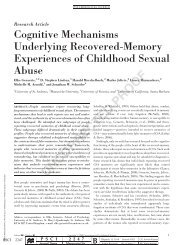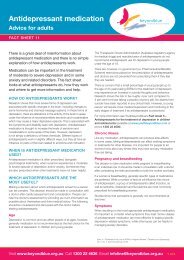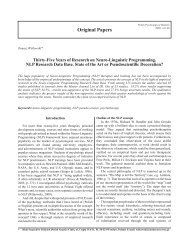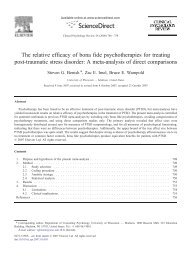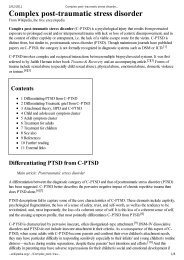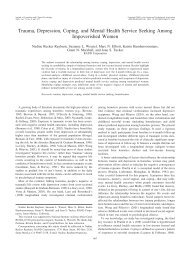The Sociocognitive Model of Dissociative Identity Disorder: A ...
The Sociocognitive Model of Dissociative Identity Disorder: A ...
The Sociocognitive Model of Dissociative Identity Disorder: A ...
You also want an ePaper? Increase the reach of your titles
YUMPU automatically turns print PDFs into web optimized ePapers that Google loves.
44 CLEAVES<br />
1994), eating disorders (EDs; Gleaves, Eberenz, Warner, &<br />
Fine, 1995; Ross, Heber, Norton, & Anderson, 1989), panic disorder<br />
(Ross, Heber, Norton, & Anderson, 1989), borderline<br />
personality disorder (Boon & Draijer, 1993b; Fink & Golink<strong>of</strong>f,<br />
1990), partial complex seizures (Ross, Heber, Anderson, et al.,<br />
1989), simple posttraumatic stress disorder (Dunn, Ryan,<br />
Paolo, & Miller, 1993), and dissociative disorder not otherwise<br />
specified (DDNOS; Ross, Anderson, et al., 1992).<br />
Given that recent research has demonstrated the complex<br />
psychopathology <strong>of</strong> DID, equating the disorder with one specific<br />
but broadly denned behavior (multiple identity enactment) is<br />
clearly unwarranted. <strong>The</strong> latter should be conceptualized as one<br />
observable behavior that may or may not be related to a feature<br />
<strong>of</strong> the disorder (identity alteration). As an analogy, equating<br />
major depressive disorder with "acting sad" would be similarly<br />
unwarranted because the former is a complex depressive disorder<br />
characterized by a clear group <strong>of</strong> depressive symptoms,<br />
whereas the latter is one specific behavior that may or may not<br />
be related to one <strong>of</strong> the symptoms <strong>of</strong> the disorder (sad affect).<br />
One could also easily generate a list <strong>of</strong> factors that affect whether<br />
one acts sad that would have little relevance to the complex psychopathology<br />
<strong>of</strong> depressive disorders.<br />
In summary, multiple identity enactment and DID are not<br />
equivalent phenomenon, and the former does not appear to be<br />
the core psychopathology <strong>of</strong> the latter. Conclusions based solely<br />
on data relevant to the concept <strong>of</strong> multiple identity enactment<br />
cannot be generalized to the complex dissociative psychopathology<br />
<strong>of</strong> DID.<br />
Clinical Presentation, Attention Seeking, and DID<br />
<strong>The</strong> assumption that individuals diagnosed as having DID<br />
are histrionic (attention seeking) and obvious in their presentation<br />
<strong>of</strong> identity-related symptoms is common among skeptics <strong>of</strong><br />
the disorder. To support this description, Spanos (1994) referred<br />
to the opinion <strong>of</strong> Thigpen and Cleckley (1984), who<br />
stated that many patients contacting them after publication <strong>of</strong><br />
their book, <strong>The</strong> Three Faces <strong>of</strong> Eve (1^1), appeared to be motivated<br />
(consciously or unconsciously) by a desire to draw attention<br />
to themselves.<br />
Although numerous individuals have drawn conclusions<br />
about DID from Thigpen and Cleckley's (1984) remarks, doing<br />
so is unwarranted because they were referring to individuals<br />
who (in Thigpen and Cleckley's opinion) did not have DID.<br />
How they could ascertain unconscious motivation mainly from<br />
phone conversations is also unclear. Furthermore, the description<br />
<strong>of</strong> the clinical presentation <strong>of</strong> DID <strong>of</strong>fered by Spanos<br />
(1994), that <strong>of</strong> someone who openly calls herself or himself by<br />
different names and behaves like different people on different<br />
occasions, is quite different from that described within the dissociative<br />
disorders literature. Clinicians and researchers within<br />
the field have regularly reported that patients with DID more<br />
commonly make active efforts to conceal the disorder because<br />
<strong>of</strong> fear <strong>of</strong> being labeled crazy, fear <strong>of</strong> disclosing their abuse histories,<br />
distrust <strong>of</strong> others, or a general avoidant characterological<br />
style (Cohen, Giller,&W., 1991;Kluft, 1991a, 1994).<br />
Ultimately, the question <strong>of</strong> clinical presentation and characterological<br />
style <strong>of</strong> patients with DID should be an empirical<br />
one, and the accumulating data do not support the position that<br />
individuals with DID or other severe dissociative psychopathology<br />
are generally histrionic or otherwise characterologically attention<br />
seeing in nature.<br />
Table 1 presents data from two recent studies <strong>of</strong> Axis II<br />
(personality disorder) diagnoses among patients having DID as<br />
compared with studies <strong>of</strong> other general clinical or nonclinical<br />
samples; diagnoses were made by structured interviews in all<br />
studies. As can be seen, the prevalence <strong>of</strong> histrionic personality<br />
disorder appears to be no higher and, in actuality, lower than in<br />
other general or specific clinical and nonclinical samples. However,<br />
avoidant personality disorder was found to be common in<br />
both <strong>of</strong> the DID samples 3 and was more common than in any<br />
<strong>of</strong> the clinical or nonclinical samples.<br />
Additional data also question the association between DID<br />
and histrionic symptomatology. Armstrong and Loewenstein<br />
(1990) administered a variety <strong>of</strong> objective and projective testing<br />
instruments to group <strong>of</strong> 14 patients with DID. <strong>The</strong> authors<br />
concluded that the personality pr<strong>of</strong>iles <strong>of</strong> the patients with DID<br />
were not histrionic or labile but rather were intellectualized,<br />
obsessive, and introversive.<br />
Fink and Golink<strong>of</strong>f (1990) administered the Millon Clinical<br />
Multiaxial Inventory-II (MCMI; Millon, 1982) to a sample <strong>of</strong><br />
16 patients with DID, as well as to a sample <strong>of</strong> patients with<br />
borderline personality disorder or schizophrenia. Although the<br />
percentage <strong>of</strong> patients meeting established cut<strong>of</strong>fs was not reported,<br />
the mean base rate score for the Histrionic scale <strong>of</strong> the<br />
MCMI was only 46.3 for the DID group, well below the cut<strong>of</strong>fs<br />
for the presence <strong>of</strong> prominent traits. <strong>The</strong> patients scored highest<br />
on the Avoidant scale (102.9), followed by the Self-Defeating<br />
scale (97.3).<br />
Other researchers have compared patients that scored high or<br />
low on standardized dissociation scales. G<strong>of</strong>f, Olin, Jenike,<br />
Baer, and Buttolph (1992) administered the <strong>Dissociative</strong> Experiences<br />
Scale (DBS), along with several assessment instruments<br />
including the Structured Interview for DSM-II1 Personality<br />
<strong>Disorder</strong>s-Revised (SIDP-R; Stangl, Pfohl, Zimmerman, Bowers,<br />
& Corenthal, 1985), to a sample <strong>of</strong> 100 clinical patients<br />
and then examined personality disorder diagnoses in the 20<br />
highest and 20 lowest scorers on the DBS. Among the 20 high<br />
scorers, only 1(5%) received a diagnosis <strong>of</strong> histrionic personality<br />
disorder. Fourteen <strong>of</strong> the 20 were diagnosed as having avoids<br />
<strong>The</strong> diagnosis <strong>of</strong> borderline personality disorder was also found to<br />
be common in these two studies. To thoroughly discuss the connection<br />
between borderline personality disorder and DID would be beyond the<br />
scope <strong>of</strong> this article. In general, research demonstrates that, although<br />
there is some overlap in phenomenology, the core symptomatology <strong>of</strong><br />
the two disorders may not be highly related (Gleaves & Eberenz,<br />
1995b), and a cluster <strong>of</strong> dissociative and Schneiderian symptoms discriminates<br />
the two disorders (Boon & Draijer, 1993b; Fink & Golink<strong>of</strong>f,<br />
1990). <strong>The</strong> overlap in some symptomatology is not surprising given the<br />
association <strong>of</strong> borderline personality disorder (BPD) with both childhood<br />
trauma (Herman, Perry, & Kolk, 1989; Murray, 1993)and posttraumatic<br />
stress disorder (PTSD;Gunderson &Chu, 1993; Gunderson<br />
&Sabo, 1993; Southwick, Yehuda, & Ciller, 1993). This latter association<br />
also questions the commonly made interpretation <strong>of</strong> borderline patients'<br />
self-injurious behaviors as purely attention seeking (Briere,<br />
1992; Gunderson & Chu, 1993).



